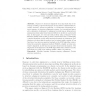439 search results - page 45 / 88 » Maximum entropy methods for biological sequence modeling |
CDC
2010
IEEE
13 years 4 months ago
2010
IEEE
Abstract-- This paper focuses on the identification of nonlinear hybrid systems involving unknown nonlinear dynamics. The proposed method extends the framework of [1] by introducin...
RECOMB
2007
Springer
14 years 9 months ago
2007
Springer
Transcription factor (TF) binding to its DNA target site is a fundamental regulatory interaction. The most common model used to represent TF binding specificities is a position spe...
ICASSP
2011
IEEE
13 years 27 days ago
2011
IEEE
Named Entity (NE) recognition from the results of Automatic Speech Recognition (ASR) is challenging because of ASR errors. To detect NEs, one of the options is to use a statistica...
RECOMB
2007
Springer
14 years 9 months ago
2007
Springer
Abstract. Sequence to structure alignment is an important step in homology modeling of protein structures. Incorporation of features like secondary structure, solvent accessibility...
ALMOB
2006
13 years 9 months ago
2006
Background: An important challenge in eukaryotic gene prediction is accurate identification of alternatively spliced exons. Functional transcripts can go undetected in gene expres...

